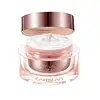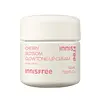What's inside
What's inside
 Key Ingredients
Key Ingredients

No key ingredients
 Benefits
Benefits

 Concerns
Concerns

 Ingredients Side-by-side
Ingredients Side-by-side

Water
Skin ConditioningButylene Glycol
HumectantGlycerin
HumectantPropanediol
SolventPolymethylsilsesquioxane
Panthenol
Skin ConditioningCI 77891
Cosmetic ColorantCyclopentasiloxane
EmollientSodium Acrylates Copolymer
Betaine
HumectantSodium Polyacrylate
AbsorbentEthylhexyl Stearate
EmollientPolysilicone-11
Isododecane
EmollientPhenoxyethanol
PreservativeChlorphenesin
AntimicrobialPolysorbate 80
EmulsifyingEthylhexylglycerin
Skin ConditioningCaprylyl Glycol
EmollientAluminum Hydroxide
EmollientTriethoxycaprylylsilane
PEG-60 Hydrogenated Castor Oil
EmulsifyingPanthenyl Ethyl Ether
Ceteareth-6
EmulsifyingParfum
MaskingBeta-Glucan
Skin ConditioningDisodium EDTA
Nymphaea Alba Root Extract
Skin ConditioningPropylene Glycol
HumectantLilium Candidum Bulb Extract
Skin ConditioningGlycyrrhiza Glabra Root Extract
BleachingSyringa Vulgaris Extract
Skin ConditioningAnthemis Nobilis Flower Extract
MaskingSaussurea Involucrata Extract
HumectantGossypium Herbaceum Extract
Skin ConditioningWater, Butylene Glycol, Glycerin, Propanediol, Polymethylsilsesquioxane, Panthenol, CI 77891, Cyclopentasiloxane, Sodium Acrylates Copolymer, Betaine, Sodium Polyacrylate, Ethylhexyl Stearate, Polysilicone-11, Isododecane, Phenoxyethanol, Chlorphenesin, Polysorbate 80, Ethylhexylglycerin, Caprylyl Glycol, Aluminum Hydroxide, Triethoxycaprylylsilane, PEG-60 Hydrogenated Castor Oil, Panthenyl Ethyl Ether, Ceteareth-6, Parfum, Beta-Glucan, Disodium EDTA, Nymphaea Alba Root Extract, Propylene Glycol, Lilium Candidum Bulb Extract, Glycyrrhiza Glabra Root Extract, Syringa Vulgaris Extract, Anthemis Nobilis Flower Extract, Saussurea Involucrata Extract, Gossypium Herbaceum Extract
Water
Skin ConditioningDimethicone
EmollientPropanediol
SolventGlycerin
HumectantDicaprylyl Carbonate
EmollientCI 77891
Cosmetic ColorantPolysorbate 80
EmulsifyingNiacinamide
Smoothing1,2-Hexanediol
Skin ConditioningBetaine
HumectantDiisostearyl Malate
EmollientTrisiloxane
Skin ConditioningAmmonium Acryloyldimethyltaurate/Vp Copolymer
Parfum
MaskingPolyacrylate-13
Hydroxyethyl Acrylate/Sodium Acryloyldimethyl Taurate Copolymer
Emulsion StabilisingDimethicone/Vinyl Dimethicone Crosspolymer
Skin ConditioningSynthetic Fluorphlogopite
Polyisobutene
Glyceryl Caprylate
EmollientAluminum Hydroxide
EmollientEthylhexylglycerin
Skin ConditioningTriethoxycaprylylsilane
Sorbitan Isostearate
EmulsifyingPolysorbate 20
EmulsifyingDisodium EDTA
Polysorbate 60
EmulsifyingPrunus Yedoensis Leaf Extract
Skin ConditioningCI 77491
Cosmetic ColorantTin Oxide
AbrasiveGeraniol
PerfumingLimonene
PerfumingTocopherol
AntioxidantSilica
AbrasiveGlycine Soja Oil
EmollientWater, Dimethicone, Propanediol, Glycerin, Dicaprylyl Carbonate, CI 77891, Polysorbate 80, Niacinamide, 1,2-Hexanediol, Betaine, Diisostearyl Malate, Trisiloxane, Ammonium Acryloyldimethyltaurate/Vp Copolymer, Parfum, Polyacrylate-13, Hydroxyethyl Acrylate/Sodium Acryloyldimethyl Taurate Copolymer, Dimethicone/Vinyl Dimethicone Crosspolymer, Synthetic Fluorphlogopite, Polyisobutene, Glyceryl Caprylate, Aluminum Hydroxide, Ethylhexylglycerin, Triethoxycaprylylsilane, Sorbitan Isostearate, Polysorbate 20, Disodium EDTA, Polysorbate 60, Prunus Yedoensis Leaf Extract, CI 77491, Tin Oxide, Geraniol, Limonene, Tocopherol, Silica, Glycine Soja Oil
 Reviews
Reviews

Ingredients Explained
These ingredients are found in both products.
Ingredients higher up in an ingredient list are typically present in a larger amount.
Aluminum Hydroxide is a form of aluminum. It can be naturally found in nature as the mineral gibbsite. In cosmetics, Aluminum Hydroxide is used as a colorant, pH adjuster, and absorbent.
As a colorant, Aluminum Hydroxide may add opacity, or reduce the transparency. Aluminum hydroxide is contains both basic and acidic properties.
According to manufacturers, this ingredient is an emollient and humectant. This means it helps hydrate the skin.
In medicine, this ingredient is used to help relieve heartburn and help heal ulcers.
There is currently no credible scientific evidence linking aluminum hydroxide in cosmetics to increased cancer risk.
Major health organizations allow the use of aluminum hydroxide in personal care products and have not flagged it as a carcinogenic risk at typical usage levels.
Learn more about Aluminum HydroxideBetaine is a common humectant (a substance that promotes retention of moisture). It's known to be gentle on the skin and can help balance hydration.
This ingredient is best for improving hydration and soothing irritated skin. Studies also show it helps even out skin tone.
Fun fact: Betaine is naturally created in the skin and body. The kind found within cosmetic products can be either plant-derived or synthetic.
Another name for betaine is trimethylglycine.
Learn more about BetaineCi 77891 is a white pigment from Titanium dioxide. It is naturally found in minerals such as rutile and ilmenite.
It's main function is to add a white color to cosmetics. It can also be mixed with other colors to create different shades.
Ci 77891 is commonly found in sunscreens due to its ability to block UV rays.
Learn more about CI 77891Disodium EDTA plays a role in making products more stable by aiding other preservatives.
It is a chelating agent, meaning it neutralizes metal ions that may be found in a product.
Disodium EDTA is a salt of edetic acid and is found to be safe in cosmetic ingredients.
Learn more about Disodium EDTAEthylhexylglycerin (we can't pronounce this either) is commonly used as a preservative and skin softener. It is derived from glyceryl.
You might see Ethylhexylglycerin often paired with other preservatives such as phenoxyethanol. Ethylhexylglycerin has been found to increase the effectiveness of these other preservatives.
Glycerin is already naturally found in your skin. It helps moisturize and protect your skin.
A study from 2016 found glycerin to be more effective as a humectant than AHAs and hyaluronic acid.
As a humectant, it helps the skin stay hydrated by pulling moisture to your skin. The low molecular weight of glycerin allows it to pull moisture into the deeper layers of your skin.
Hydrated skin improves your skin barrier; Your skin barrier helps protect against irritants and bacteria.
Glycerin has also been found to have antimicrobial and antiviral properties. Due to these properties, glycerin is often used in wound and burn treatments.
In cosmetics, glycerin is usually derived from plants such as soybean or palm. However, it can also be sourced from animals, such as tallow or animal fat.
This ingredient is organic, colorless, odorless, and non-toxic.
Glycerin is the name for this ingredient in American English. British English uses Glycerol/Glycerine.
Learn more about GlycerinParfum is a catch-all term for an ingredient or more that is used to give a scent to products.
Also called "fragrance", this ingredient can be a blend of hundreds of chemicals or plant oils. This means every product with "fragrance" or "parfum" in the ingredients list is a different mixture.
For instance, Habanolide is a proprietary trade name for a specific aroma chemical. When used as a fragrance ingredient in cosmetics, most aroma chemicals fall under the broad labeling category of “FRAGRANCE” or “PARFUM” according to EU and US regulations.
The term 'parfum' or 'fragrance' is not regulated in many countries. In many cases, it is up to the brand to define this term.
For instance, many brands choose to label themselves as "fragrance-free" because they are not using synthetic fragrances. However, their products may still contain ingredients such as essential oils that are considered a fragrance by INCI standards.
One example is Calendula flower extract. Calendula is an essential oil that still imparts a scent or 'fragrance'.
Depending on the blend, the ingredients in the mixture can cause allergies and sensitivities on the skin. Some ingredients that are known EU allergens include linalool and citronellol.
Parfum can also be used to mask or cover an unpleasant scent.
The bottom line is: not all fragrances/parfum/ingredients are created equally. If you are worried about fragrances, we recommend taking a closer look at an ingredient. And of course, we always recommend speaking with a professional.
Learn more about ParfumPolysorbate 80 is a surfactant and emulsifier. It is used to keep ingredients together, and prevent oils and waters from separating.
It is made from polyethoxylated sorbitan and oleic acid. This ingredient can be found in cosmetics, foods, and medicine. It is water-soluble.
Polysorbate 80 may not be fungal acne safe.
Learn more about Polysorbate 80Propanediol is an all-star ingredient. It softens, hydrates, and smooths the skin.
It’s often used to:
Propanediol is not likely to cause sensitivity and considered safe to use. It is derived from corn or petroleum with a clear color and no scent.
Learn more about PropanediolTriethoxycaprylylsilane is a silicone used to bind and stabilize ingredients.
As an emulsifier, it helps prevent ingredients from separating. This can help elongate the shelf life of products.
Triethoxycaprylylsilane is often used to coat mineral sunscreens ingredients to help give a better feel. It also helps reduce oxidative stress in sunscreens.
Learn more about TriethoxycaprylylsilaneWater. It's the most common cosmetic ingredient of all. You'll usually see it at the top of ingredient lists, meaning that it makes up the largest part of the product.
So why is it so popular? Water most often acts as a solvent - this means that it helps dissolve other ingredients into the formulation.
You'll also recognize water as that liquid we all need to stay alive. If you see this, drink a glass of water. Stay hydrated!
Learn more about Water